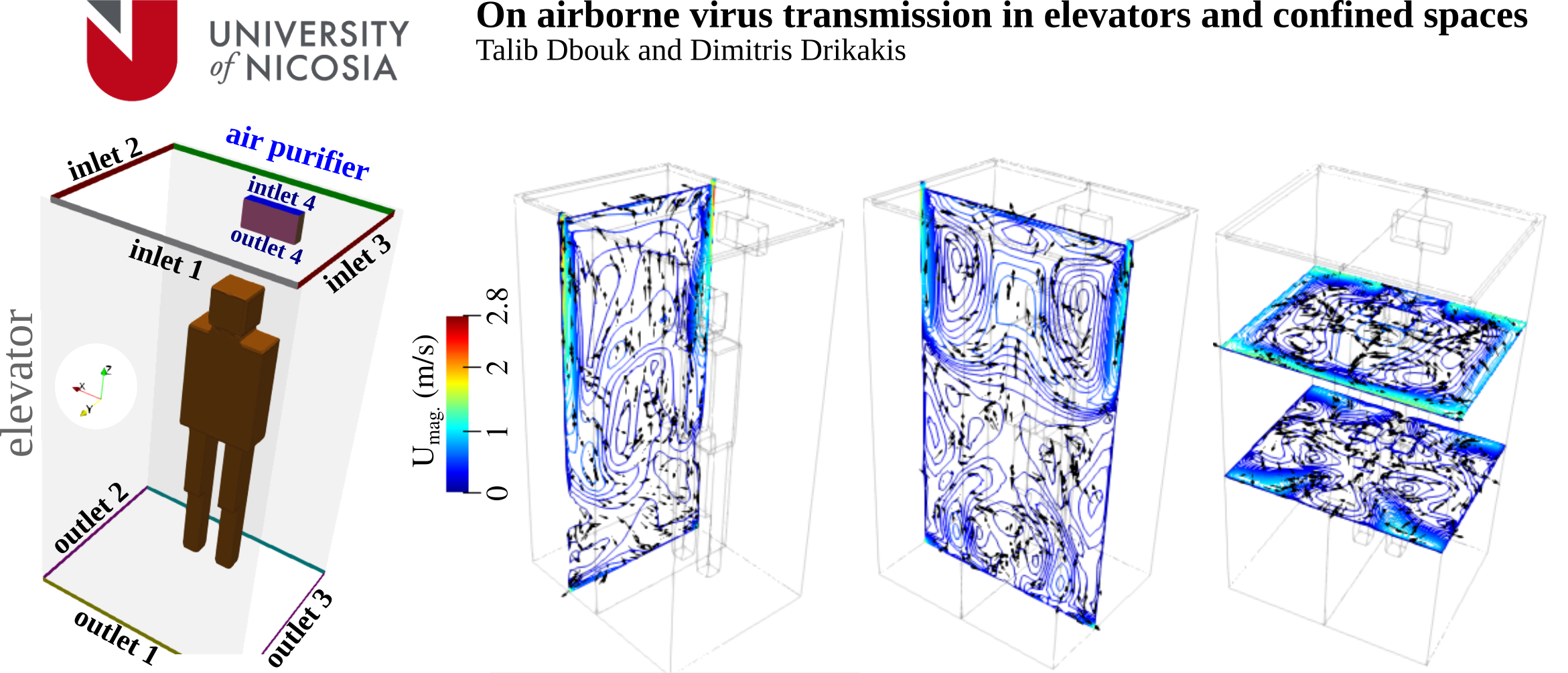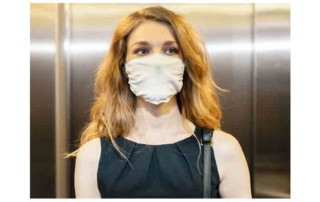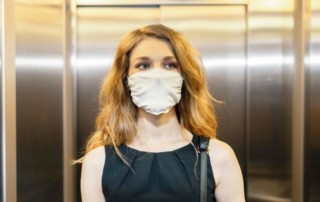COVID-19
UNIC Coronavirus Health and Research Portal
On Airborne Virus Transmission in Confined Spaces
Talib Dbouk and Dimitris Drikakis
University of Nicosia, Nicosia, Cyprus
The impact of air ventilation systems on airborne virus transmission, and aerosols in general, in confined spaces, is not yet understood.
The recent pandemic has made it crucial to understand the limitations of ventilation systems regarding virus transmission.
Let us consider an elevator as a prototypical example of a confined space and show how ventilation designs alone, regardless of cooling or heating, contribute to the airborne virus transmission.
In this study, we investigated air circulation effects inside an elevator by employing advanced multiphase computational fluid dynamics. We were interested in the performance of an air purifier installed in an elevator for reducing airborne virus transmission.
For the above reasons, we have investigated three different flow scenarios regarding the position and operation of inlets and outlets inside the elevator, and a fourth scenario that includes the operation of the air purifier.
Interestingly, we found that the position of the inlets and outlets significantly influences the flow circulation and droplet dispersion. More importantly, we found that an air purifier installed inside an elevator does not eliminate airborne virus transmission.
Figure 1
The geometry shows the different inlets and outlets (with 3 cm openings width) in an elevator. A subject is standing in the elevator’s cabin such that the subject’s mouth as a coughing source is positioned at x = 0 m, y= 0.41 m, z = 1.6 m. An air purifier (sanitizer) is also attached to the wall at about 1.9 m above the elevator’s cabin’s ground. The air purifier has an air intake (outlet 4) and air exhaust (inlet 4) for air circulation at ≈60 m3 /h. At the right sides (blue images with black arrows) is an example of air circulation for a specific scenario A showing the velocity magnitude at different planes. The environment is at 20 °C and 50% relative humidity. For this scenario D conditions, see Dbouk and Drikakis, Physics of Fluids, 33, 011905, (2021).
Figure 2
Local dispersion of contaminated saliva droplets inside an elevator’s cabin due to the presence of an air purifier. Top column: front view. Middle column: top view. Bottom column: side view. Contaminated saliva droplets are illustrated in black after being scaled by a factor of about 250 for their actual size. Subject position 2 corresponds to a person standing in the elevator’s cabin such that her/his mouth as a coughing source is positioned at x = 0 m, y = 0.675 m, z = 1.6 m. For this scenario D conditions, see Dbouk and Drikakis, Physics of Fluids, 33, 011905, (2021).
What Does This Mean?
In confined spaces such as an elevator, the placement of ventilation inlets and outlets significantly influences the flow circulation and droplet dispersion. Without an air purifier, the case of a single inlet and outlet exhibits the least droplet dispersion. The subject’s position inside the cabin also influences the flow circulation and droplet spread. The air purifier reduces the droplet dispersion but will not eliminate it. The air intake integrated inside the purifier equipment induces flow circulation that can add to the contaminated saliva droplets in the cabin. The time required for droplets reaching the elevator floor could be larger than the time necessary to deactivate the virus by other means such as UV radiation. Thus, the success of air purifiers lies in addressing the issue mentioned above. The present study’s results are pertinent to any confined spaces, including small rooms in residential or commercial facilities, car parks, shops, and an aircraft cabin, submarines, and spacecraft.
The broader implications of the present findings are that health and safety authorities must revise guidelines accordingly by considering the flow circulation and droplet dispersion effects from air purifiers and sanitizers in confined spaces. The design of future ventilation and purification systems should reduce airborne virus transmission through minimization of droplet dispersion.
Video 1
Contaminated saliva droplets dispersion inside an elevator’s cabin due to an operating air purifier: The air purifier induces local air circulations represented by the velocity contours isosurfaces. The contaminated saliva droplets are illustrated in black dots.
The University of Nicosia (UNIC)
About the University of Nicosia
The University of Nicosia (UNIC) is the largest university in Cyprus, and the largest university in southern Europe that teaches primarily in English, welcoming 12,000+ students from over 70 countries worldwide. The University of Nicosia is a comprehensive university with 6 schools, 20 departments and over 100 degree programs offered on-campus and online.
The University of Nicosia is best known in the fields of medicine, law, blockchain, accounting, education, forecasting and international relations and for a series of partnerships with other leading European universities. UNIC was most recently ranked #106 in its region by QS and #300 to #400 globally in the Times Higher Education Impact rankings.
To learn more about the University of Nicosia, please see: https://www.unic.ac.cy/
UNIC’s COVID-19 Response
University of Nicosia faculty across a variety of academic disciplines are actively engaged in research and analysis and serving in scientific / public policy roles supporting the global COVID-19 response.
For more information about the University of Nicosia’s work relating to COVID-19 including potential collaboration, please see: https://www.unic.ac.cy/coronavirus/
Contact Information
For more information about this study, please contact Prof Dimitris Drikakis at [email protected].
For more information on our COVID-19 related research in general, please contact UNIC at [email protected].
Press Coverage
Articles and press mentions in global media about the research.
Τα συστήματα καθαρισμού αέρα μπορεί να αυξήσουν εξάπλωση ιών, εντοπίζει έρευνα Πανεπιστημίου Λευκωσίας
Τα συστήματα καθαρισμού αέρα μπορεί να αυξήσουν εξάπλωση ιών, εντοπίζει έρευνα Πανεπιστημίου Λευκωσίας Η χρήση εξαερισμού αυξάνει τον ρυθμό με τον οποίο δυνητικά μολυσμένος αέρας μπορεί να κυκλοφορήσει σε κλειστούς χώρους, όπως οι ανελκυστήρες, σύμφωνα με τους ερευνητές του Πανεπιστημίου Λευκωσία Talib Dbouk και Δημήτρη Δρικάκη, σε έρευνά τους η οποία δημοσιεύεται στο επιστημονικό περιοδικό Physics of Fluids. Όπως αναφέρεται σε ανακοίνωση του Πανεπιστημίου Λευκωσίας «οι θέσεις των εισόδων και εξόδων αέρα σε περιορισμένους χώρους, όπως ανελκυστήρες, επηρεάζουν σημαντικά τη [...]
Έρευνα UNIC: Ο εξαερισμός μπορεί να αυξήσει την εξάπλωση ιών
Έρευνα UNIC: Ο εξαερισμός μπορεί να αυξήσει την εξάπλωση ιών Τα συστήματα καθαρισμού αέρα μπορεί να αυξήσουν εξάπλωση ιών, εντοπίζει έρευνα Πανεπιστημίου Λευκωσίας Η χρήση εξαερισμού αυξάνει τον ρυθμό με τον οποίο δυνητικά μολυσμένος αέρας μπορεί να κυκλοφορήσει σε κλειστούς χώρους, όπως οι ανελκυστήρες, σύμφωνα με τους ερευνητές του Πανεπιστημίου Λευκωσία Talib Dbouk και Δημήτρη Δρικάκη, σε έρευνά τους η οποία δημοσιεύεται στο επιστημονικό περιοδικό Physics of Fluids. Όπως αναφέρεται σε ανακοίνωση του Πανεπιστημίου Λευκωσίας «οι θέσεις των εισόδων και [...]
Τα συστήματα καθαρισμού αέρα μπορεί να αυξήσουν εξάπλωση ιών, εντοπίζει έρευνα Πανεπιστημίου Λευκωσίας
Τα συστήματα καθαρισμού αέρα μπορεί να αυξήσουν εξάπλωση ιών, εντοπίζει έρευνα Πανεπιστημίου Λευκωσίας Η χρήση εξαερισμού αυξάνει τον ρυθμό με τον οποίο δυνητικά μολυσμένος αέρας μπορεί να κυκλοφορήσει σε κλειστούς χώρους, όπως οι ανελκυστήρες, σύμφωνα με τους ερευνητές του Πανεπιστημίου Λευκωσία Talib Dbouk και Δημήτρη Δρικάκη, σε έρευνά τους η οποία δημοσιεύεται στο επιστημονικό περιοδικό Physics of Fluids. Όπως αναφέρεται σε ανακοίνωση του Πανεπιστημίου Λευκωσίας «οι θέσεις των εισόδων και εξόδων αέρα σε περιορισμένους χώρους, όπως ανελκυστήρες, επηρεάζουν σημαντικά τη [...]
Τα συστήματα καθαρισμού αέρα μπορεί να αυξήσουν την εξάπλωση των ιών
Τα συστήματα καθαρισμού αέρα μπορεί να αυξήσουν την εξάπλωση των ιών Οι ερευνητές του Πανεπιστημίου Λευκωσίας Dbouk και Δρικάκης, επιστρέφουν με σημαντικές πληροφορίες σχετικά με τον COVID-19. Σύμφωνα με την τελευταία τους δημοσίευση στο Physics of Fluids, η χρήση εξαερισμού αυξάνει τον ρυθμό με τον οποίο δυνητικά μολυσμένος αέρας μπορεί να κυκλοφορήσει σε κλειστούς χώρους. Οι θέσεις των εισόδων και εξόδων αέρα σε περιορισμένους χώρους, όπως ανελκυστήρες, επηρεάζουν σημαντικά τη μετάδοση των ιών. Στην τέταρτη σχετική δημοσίευσή τους αναφορικά με [...]
Τα συστήματα καθαρισμού αέρα δύναται να αυξήσουν την εξάπλωση των ιών
Τα συστήματα καθαρισμού αέρα δύναται να αυξήσουν την εξάπλωση των ιών Οι θέσεις των εισόδων και εξόδων αέρα σε περιορισμένους χώρους, όπως ανελκυστήρες, επηρεάζουν σημαντικά τη μετάδοση των ιών. Στην τέταρτη σχετική δημοσίευσή τους αναφορικά με τη μεταφορά του ιού στον αέρα σε ανελκυστήρες και περιορισμένους χώρους (Airborne Virus Transmission in Elevators and Confined Spaces), που δημοσιεύτηκε στο επιστημονικό περιοδικό Physics of Fluids του Αμερικανικού Ινστιτούτου Φυσικής (AIP Publishing), οι Δρ. Talib Dbouk και Καθηγητής Δημήτρης Δρικάκης του Πανεπιστημίου Λευκωσίας, [...]
Τα συστήματα καθαρισμού αέρα δύναται να αυξήσουν την εξάπλωση των ιών
Τα συστήματα καθαρισμού αέρα δύναται να αυξήσουν την εξάπλωση των ιών Οι ερευνητές του Πανεπιστημίου Λευκωσίας Dbouk και Δρικάκης, επιστρέφουν με σημαντικές πληροφορίες σχετικά με τον COVID-19. Σύμφωνα με την τελευταία τους δημοσίευση στο Physics of Fluids, η χρήση εξαερισμού αυξάνει τον ρυθμό με τον οποίο δυνητικά μολυσμένος αέρας μπορεί να κυκλοφορήσει σε κλειστούς χώρους. Οι θέσεις των εισόδων και εξόδων αέρα σε περιορισμένους χώρους, όπως ανελκυστήρες, επηρεάζουν σημαντικά τη μετάδοση των ιών. Στην τέταρτη σχετική δημοσίευσή τους αναφορικά με [...]
Τα συστήματα καθαρισμού αέρα δύναται να αυξήσουν την εξάπλωση των ιών
Οι ερευνητές του Πανεπιστημίου Λευκωσίας Dbouk και Δρικάκης, επιστρέφουν με σημαντικές πληροφορίες σχετικά με τον COVID-19. Σύμφωνα με την τελευταία τους δημοσίευση στο Physics of Fluids, η χρήση εξαερισμού αυξάνει τον ρυθμό με τον οποίο δυνητικά μολυσμένος αέρας μπορεί να κυκλοφορήσει σε κλειστούς χώρους.
Temperature, Humidity – Wind Predict Second Wave of COVID-19 Pandemic
Weather parameters, typically excluded from pandemic modeling, improve prediction capabilities. The “second wave” of the coronavirus pandemic has placed much blame on a lack of appropriate safety measures. However, due to the impacts of weather, research suggests two outbreaks per year during a pandemic are inevitable. Read the full article here: Weather parameters, typically excluded from pandemic modeling, improve prediction capabilities.
Temperature, humidity, wind predict second wave of pandemic
Temperature, humidity, wind predict second wave of pandemic The 'second wave' of the coronavirus pandemic has resulted in much blame placed on a lack of appropriate safety measures. However, due to the impacts of weather, research suggests two outbreaks per year during a pandemic are inevitable. Read the full article here: Temperature, humidity, wind predict second wave of pandemic Source: Temperature, humidity, wind predict second wave of pandemic
If You Have This at Home, You May Be More Likely to Get COVID
If You Have This at Home, You May Be More Likely to Get COVID While much has been made about air purification techniques potentially helping to mitigate COVID transmission indoors, new research suggests that, in some cases, air purifiers may actually increase the spread of COVID. Read on to discover if what you're doing to protect yourself at home could actually be putting you in harm's way. According to a Jan. 26 study published in the journal Physics of Fluids, [...]












